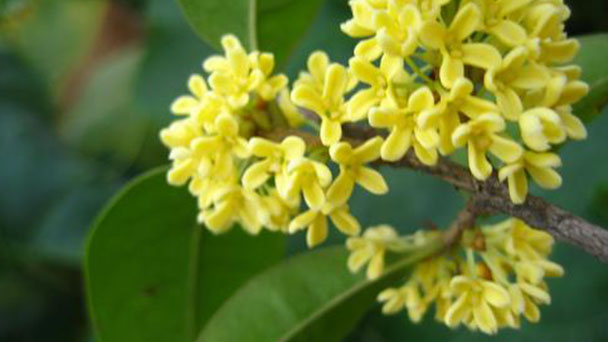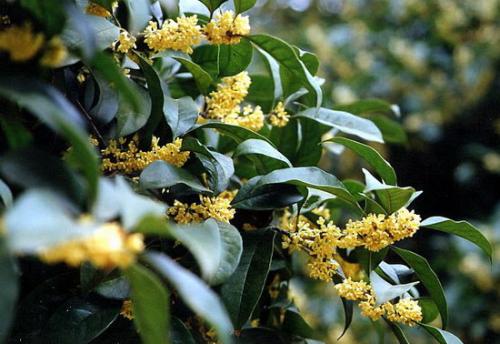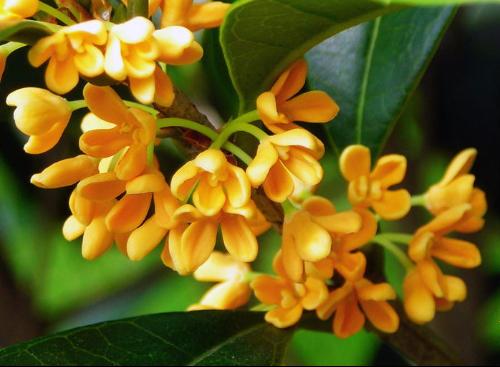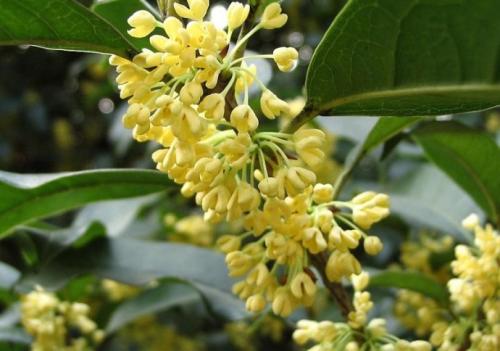Sweet Osmanthus Profile
Written by Maggie
Oct 19 2021

Sweet Osmanthus, scientific name Osmanthus fragrans, is one of the top ten traditional flowers in China. It is an excellent garden tree with ornamental and practical features, integrating greening, beautification and fragrance. Sweet Osmanthus is a unique tree with clear, strong and far overflow. Especially in the Mid-Autumn season, the cluster of laurels in full bloom, the night static round occasion, wine appreciate laurel, Chen Xiang tangy, refreshing. In ancient Chinese poetry, the number of laurel poems is also considerable. Since ancient times, it has been deeply loved by the Chinese people and regarded as a famous traditional flower.
Sweet Osmanthus tea, which is made from Sweet Osmanthus, is a special tea in China. It has a soft aroma and a delicious taste, which is popular with the public. sweet osmanthus is widely used in garden construction.
Sweet Osmanthus Picture

Sweet Osmanthus Characteristics
Sweet Osmanthus Shape
Sweet Osmanthus is an evergreen tree or shrub that is 3-5 meters tall and can reach a maximum of 18 meters; The bark is grayish brown. Branchlets are yellowish-brown, glabrous.
Sweet Osmanthus Leaf
Sweet osmanthus leaf blade leathery, elliptic, elliptic or elliptic-lanceolate, 7-14.5 cm long, 2.6 4.5 cm wide, apex abruptly acuminate, base gradually narrow cuneate or broadly cuneate, margin entire or upper usually finely toothed, two sides glabrous, glandular dots on the two sides together as small bullet protuberant, midrib above recess, raised below, lateral veins 6-8 pairs, as many as 10, in the recess, below raised; Petiole is 0.8-1.2 cm long, up to 15 cm, glabrous.
Sweet Osmanthus Flower
Sweet Osmanthus is cymes clustered in leaf axils, or almost broomlike, with many flowers in each axle; Bracts are broadly ovate, thick, 2-4 mm long, apiculate, glabrous; Pedicels are slender, 4-10 mm long, glabrous; The flowers are very fragrant; Calyx ca. is 1 mm, lobes slightly irregular; Corolla is yellow-white, pale yellow, yellow, or orange, 3 -- 4 mm long, corolla tubes only 0.5 -- 1 mm long; Stamens are born in middle of corolla tube, filaments very short, ca. 0.5 mm long, anthers ca. 1 mm long, the septum slightly extended at the apex of anthers with inconspicuous small points; Pistil ca. is 1.5 mm, style ca. 0.5 mm.
Sweet osmanthus blooms from September to early October.
Sweet Osmanthus Fruit
Sweet osmanthus fruit is skewed, oval, 1-1.5 cm long and purplish black.
Sweet Osmanthus fruit in March of the next year.
Sweet Osmanthus Native Habits
Sweet Osmanthus is adapted to subtropical climates and prefers warm, humid climates. The average temperature in the planting area is 14 ~ 28℃, the average temperature in July is 24 ~ 28℃, and the average temperature in January is above 0℃. The lowest temperature can be -13℃, and the optimal growth temperature is 15 ~ 28℃. Humidity is very important for the growth and development of Sweet osmanthus. The annual average humidity is required to be 75% ~ 85%, and the annual precipitation is about 1000 mm. Especially when young and adult trees bloom, they need more moisture.

Sweet Osmanthus Distribution
Sweet Osmanthus is native to the eastern part of the Himalayas in southwest China, and is also found in India, Nepal and Cambodia. Sweet Osmanthus grows in the wild in Southwest China, Sichuan, Southern Shaanxi, Yunnan, Guangxi, Guangdong, Hunan, Hubei, Jiangxi, Anhui, Henan and other provinces. It is now widely grown in the Huaihe River Basin and the south of the region. Its suitable area can reach the lower reaches of the Yellow River in the north and Guangxi, Guangdong, Hainan and other places in the south.
The growth area has good hydrothermal conditions and suitable precipitation. The soil is mostly yellow brown soil or yellow brown soil, and the vegetation is mainly subtropical broad-leaved forest.Under the above conditions, Sweet osmanthus grew well and formed several famous Sweet osmanthus production bases in Anhui Lu 'an, Hubei Xianning, Hunan Taoyuan, Jiangsu Suzhou, Guangxi Guilin, Hubei Wuhan, Zhejiang Hangzhou and Sichuan Chengdu.
Sweet Osmanthus Benefits
Medicinal value
Efficacy: Sweet Osmanthus extract is pale yellow and fragrant, which can be used in food, cosmetics, cakes, candies and wine making. Sweet Osmanthus is pungent and can be used as medicine. Flowers, fruits and roots are used as medicine. Picking flowers in autumn; Fruit picking in spring; Roots are collected in four seasons and dried in the sun. Fruit: spicy, sweet, warm. Root: sweet, slightly astringent, flat. Function: flower: disperse cold break knot, dissolve phlegm cough. Used for toothache, cough and asthma sputum, amenorrhea abdominal pain. Fruit: warm stomach, smooth liver, disperse cold.Used for deficiency cold stomach ache. Root: dispelling wind and dampness, dispersing cold.Used for rheumatic muscle and bone pain, lumbago, kidney deficiency and toothache.
Ornamental value
Sweet Osmanthus is evergreen, leafy and flowering in autumn. It is widely used in gardens. It is often used as a landscape tree, either solitary or in pairs, or in clusters and forests. In China's classical gardens, Sweet Osmanthus is often paired with buildings, mountains and stones, and planted near pavilions, terraces, buildings and pavilions in the form of clustered shrubby plants. Sweet Osmanthus is resistant to harmful gases such as sulfur dioxide and hydrogen fluoride. It is also a good green plant in industrial and mining areas.
It is often used for garden appreciation, community, garden, school, institution, factory, hillside, courtyard, roadside, before the building.When in full bloom, the flowers are full of branches, so that the fragrance is overflowing, with a high ornamental value, is actually the ideal tree to beautify the courtyard.
Sweet Osmanthus is a fragrant, flavorful substance that can be used to eat or extract spices.

Read Next:
How to Propagate Sweet Osmanthus
How to Grow & Care for Sweet Osmanthus
Latest Updated
- Benefits of Bugleweed - 7 Science-backed Health Benefits
- Bugleweed Dangers & Side Effects - Is It Poisonous?
- How to Plant Evergreen Trees - What You Should Know
- When to Plant Evergreens - Grow Guide for Evergreen Trees
- 12 Wonderful Evergreen Shrubs for Your Garden
- 12 Popular Evergreen Plants with Pictures for Beginners
- When And How To Prune A Lilac Bush Like a Pro
- How to Grow & Care for Lilac Vine (Hardenbergia Violacea)
- Japanese Lilac Tree (Syringa Reticulata) Care & Propagation Guide
- Shumard Oak Pros and Cons - What to Know
Popular Articles
- Winter maintenance of Antirrhinum Majus
- How to Grow Terminalia Mantaly Tree
- How to Grow and Care for Crossostephium Chinense
- How to grow Antirrhinum Majus in spring
- Peristeria Elata (Dove Orchid) Profile: Info & Care Guide
- Underwatered Snake Plant (Sansevieria Trifasciata) - Signs And How To Fix
- How to Care for Brazilian Jasmine Plant (Mandevilla Sanderi)
- How to Grow & Care for Graptopetalum Purple Delight in Summer
- Rosa Chinensis (China Rose): Plant Growing & Care Tips
- How to Care for Baby Sun Rose (Aptenia Cordifolia)